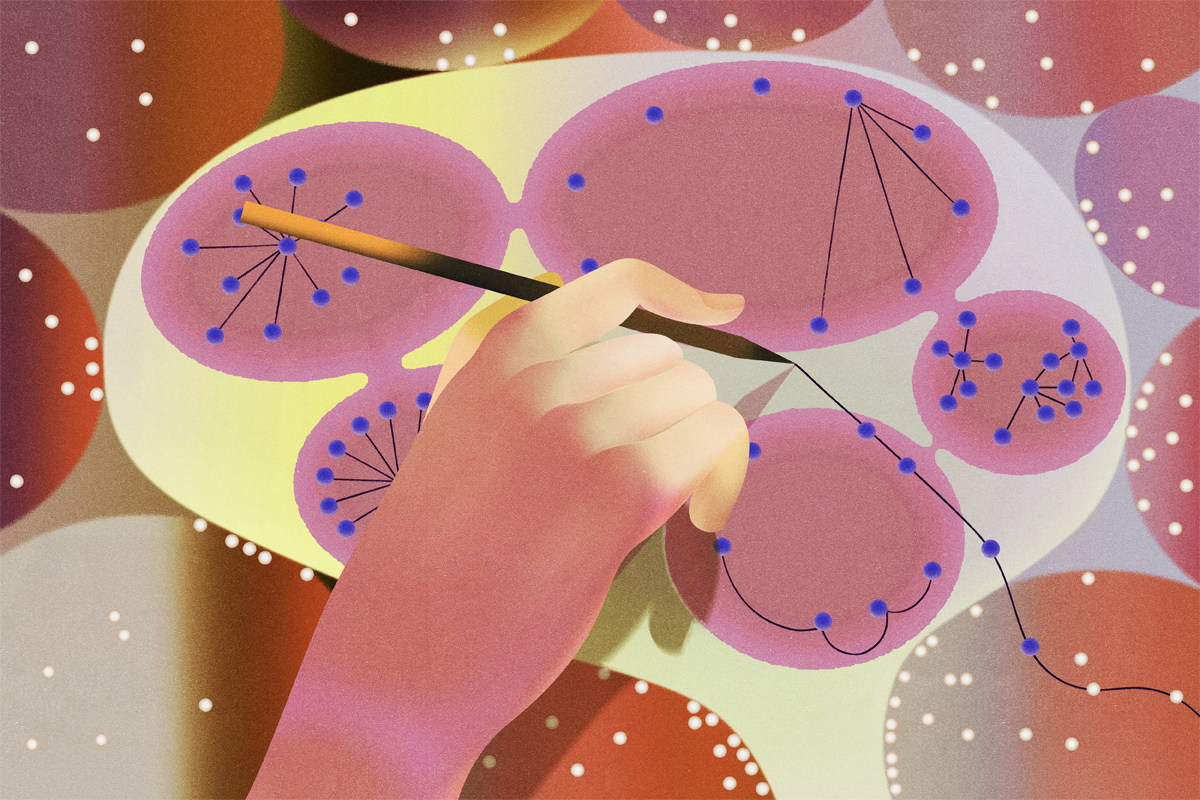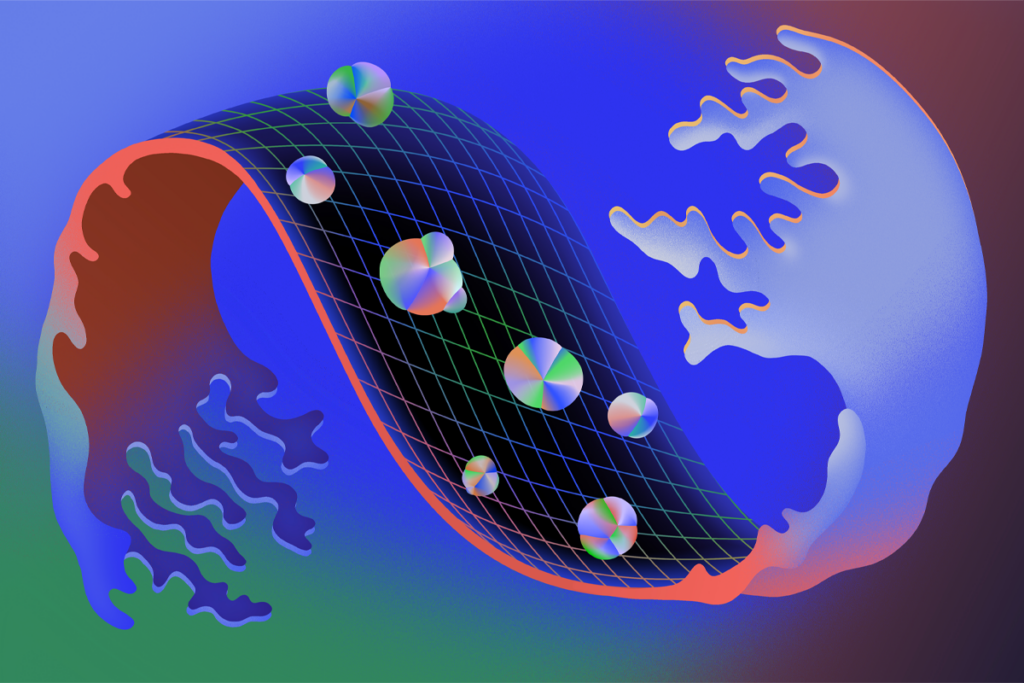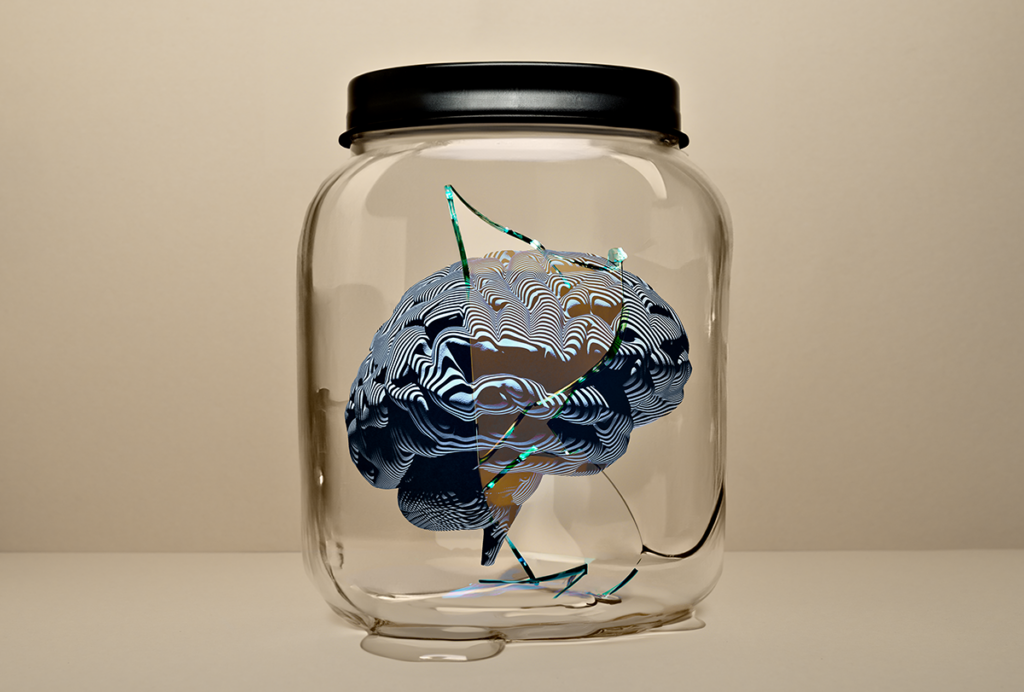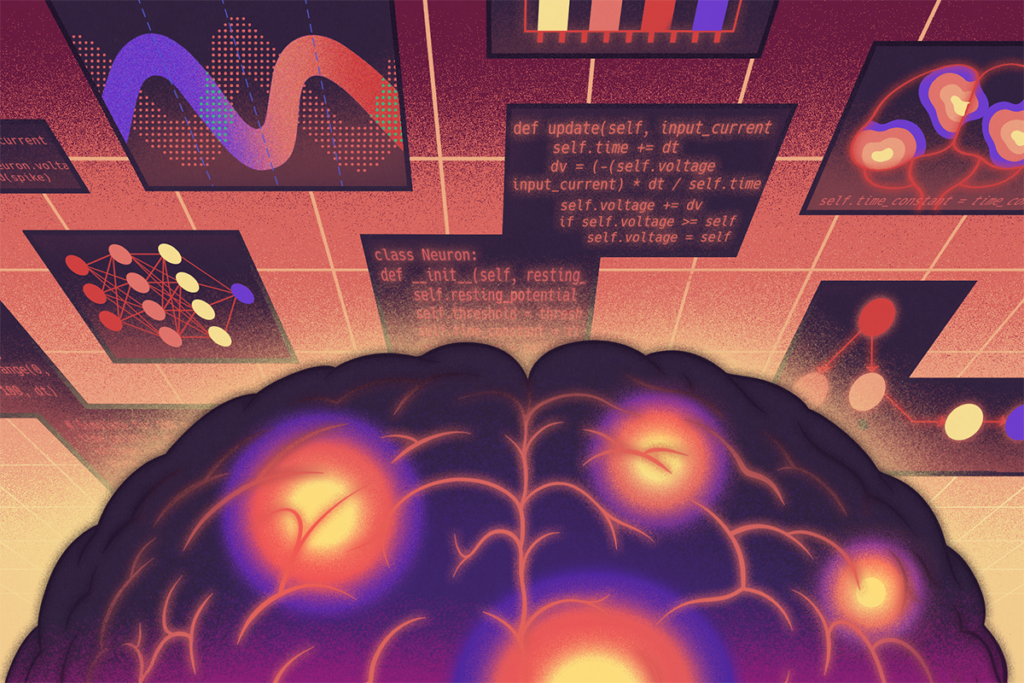
Beyond Newtonian causation in neuroscience: Embracing complex causality
The traditional mechanistic framework must give way to a richer understanding of how brains actually generate behavior over time.
Understanding causation is fundamental to neuroscience as researchers seek to identify what gives rise to behaviors and cognitive states. Traditionally, neuroscience has favored mechanistic explanations, which emphasize precise neural pathways and signals that directly generate behaviors. For instance, researchers often demonstrate “driving causation” in rodents by optogenetically stimulating specific circuits, such as central amygdala neurons, to elicit fear-related behaviors, such as freezing. But the limitations of purely mechanistic explanations have become increasingly apparent, at least to some researchers. A recent paper by Kevin Mitchell, professor of genetics and neuroscience at Trinity College Dublin, and his graduate student Henry Potter, highlights the desirability—indeed necessity—of broadening our causal framework beyond mechanisms to include richer perspectives that better capture the complexity of living systems and cognition.
Central to Mitchell and Potter’s argument is “criterial causation,” a concept developed by Peter Ulric Tse, professor of psychological and brain sciences at Dartmouth College, in his 2013 book, “The Neural Basis of Free Will: Criterial Causation,” challenging the classic neuroscientific approach that views neuronal firing, or action potentials, as the primary determinant of behavior. Unlike traditional “driving causation,” in which one action potential directly triggers another in a domino-like sequence, criterial causation emphasizes the broader conditions under which neural activity becomes effective in producing behavior. It suggests that a postsynaptic neuron’s dynamic synaptic weights, threshold, glial cell inputs and other contextual factors play crucial causal roles, acting as conditions or “criteria” that determine whether a presynaptic neuron’s action potential inputs will lead to specific outcomes, such as the release of an action potential.
Mitchell and Potter take this idea one step further, advocating for a non-reductive, pluralistic approach to causation. They argue that neuroscience should embrace multiple causal frameworks, including not only mechanistic and criterial causation but also historical and semantic causation. Historical causation emphasizes the role of temporal factors—such as developmental processes and past experiences—that shape the current neural landscape. This perspective contrasts starkly with the traditional “synchronic view,” which narrowly focuses on immediate neural states.
Semantic causation shifts the focus from purely physical interactions to the meaning or informational content encoded by neural patterns. By positing that neural signals derive their causal power from the meanings they represent to the organism—based on past experiences and adaptive significance—this concept links neuroscience directly to cognitive science and philosophy of mind, bridging the neural and the cognitive. Reversal learning tasks offer a brief example of semantic causation; the same sensory cue, such as a tone, initially associated with reward and approach behavior can, after reversal learning, come to signal punishment and prompt avoidance. Here, identical neural inputs (from the auditory cortex) are interpreted (by the orbitofrontal cortex) differently based on historical context and current state, highlighting causation rooted in meaning of the incoming activation pattern.
Finally, Mitchell and Potter engage deeply with the implications of historical and semantic causation for long-standing philosophical debates about how mental states can cause physical actions (mental causation) and whether we can be genuine originators of our behavior rather than mere links in a causal chain (agent causation). They argue that incorporating these broader notions of causation can meaningfully contribute to understanding consciousness, cognition, agency and free will, thereby inviting neuroscientists to reconsider some of their foundational assumptions about the mind-brain relationship.
To explore these ideas further, I posed two questions to Mitchell, Tse and Aliya Rumana, assistant professor of philosophy at the University of Texas at El Paso, whose work focuses on issues of explanation, modeling and analysis across neuroscience and psychology. The discussion that followed aims to explore how to integrate these expansive causal concepts into neuroscientific research, consider their implications for scientific rigor and explanatory power, and assess how these ideas could help reshape our understanding of cognition, consciousness and agency.
Kevin Mitchell, Trinity College Dublin
The traditional view of causation in neuroscience involves a “driving” metaphor, in which activation of one set of neurons drives downstream neurons, which drive further-downstream neurons, which eventually drive behavior. This view is inherited from seminal studies on sensorimotor reflex circuits and underlies the interpretation of many optogenetic manipulations. This perspective casts the brain as a complicated stimulus-response machine and identifies the neural activity itself as providing the causal “oomph” in the system.
But these kinds of “production causes”—physical events that drive other physical events—are not the only kinds of causes at play. There are also “dependence causes”—the states and propensities of the system that explain why some neural activity has the effects it does. In the nervous system, these crucially include the configuration of synaptic connections between and within populations of neurons. Collectively, these embody what Peter Tse calls criterial causes—the criteria for a neuron to fire (or not) when it receives various patterns of incoming activity.
Focusing our attention on these criterial causes shifts our view from one in which the downstream neuron is being passively driven by its inputs to one in which it is actively interpreting those inputs. Neurons—both individually and as populations—are selectively tuned to patterns in their inputs, patterns that carry some meaning in the system. These meaningful patterns are often multiply realizable—that is, they can differ in low-level details and still be interpreted in the same way by downstream neurons. The idea that the neural “vehicles” do all the real causal work is thus not accurate, as the low-level details are often arbitrary and incidental. The causal effects of any patterns of neural activity depend in crucial ways on their “content”—the meaning that inheres in the way the patterns are interpreted.
We are already seeing this conceptual paradigm emerging from the empirical literature itself, with new computational tools revealing how the rest of the nervous system makes sense of any given local patterns of activity. What we hope to have provided in our paper is a set of philosophical resources that can ground these efforts within a wider conceptual framework. Under this view, we can see the machine at work and even manipulate its workings, while realizing that it is meaning that drives the mechanism.
That meaning is grounded by the history of the organism (and the evolutionary history of the species). A full explanation of why some behavior occurred thus requires a temporally extended, or “diachronic,” view of causation. But the meanings are not static. As Peter Tse has described, the criteria that any neuron operates under are highly dynamic and can be modulated, in real time, by all sorts of contextual parameters. Whenever beliefs about the state of the world are updated or a new goal is adopted or attention is directed toward something, these criteria can be changed. That is how those “mental” activities are causally implemented in the neural system.
For empirical neuroscientists, this kind of context is often intentionally excluded from our tightly controlled lab experiments. But as we move toward more naturalistic experiments in more complex and dynamic environments, along with the technological and computational tools for more whole-brain recordings and analyses, we should, hopefully, see a more holistic neuroscience emerging, in which the behavior of the organism is not seen as being driven by isolated neural events within it, but the organism is seen instead as an agent using its neural machinery to make sense of the world and actively adapt its behavior accordingly.
Aliya Rumana, University of Texas at El Paso
I thank Henry Potter and Kevin Mitchell for their interesting and generative paper. I agree with them (and with Peter Tse) that modern neuroscience is too fixated on the triggering or driving causes of behavior, but I’m afraid (relieved) that they might overestimate the problem.
Take a structure like a neuron and a function like an action potential. In a case like this, what Tse calls “causal criteria” are the conditions under which a neuron will produce an action potential. This is a kind of “structure-function relationship.” By calling a structure-function relationship a kind of cause—i.e., a “criterial cause”—Tse lumps structure-function relationships together with functions under the umbrella of causation.
Potter and Mitchell offer support for this lumping move. They note that experimental manipulations can target either functions (as in optogenetics, in which lasers are used to drive action potentials) or structures (as in lesioning, in which architecture is changed, i.e., degraded). This is a kind of unity from the perspective of experimental manipulation: Both are possible targets, so both should be understood as causes (given an interventionist picture of causation).
But biological interventions and recordings aren’t the primary means by which we identify structure-function relationships. When we want to discover a neuron’s response criteria, we rarely intervene on its structure (we currently lack the fine-grained control required to do this well). Most of the time, we observe its functional responses across a range of tasks and task conditions. In other words, we generally intervene on the task, not the brain.
From a task perspective, structure-function relationships look very different from functions. Tasks exert a variety of constraints on organisms and the structures inside of them, which must satisfy those constraints to make performance on the task possible for the organism. This explanation comes first, in a sense. Only after we understand how task performance is possible for the organism can we understand how the organism does activities, which convert task performance from a mere possibility into a bona fide actuality.
Thus, structure-function relationships are “potentialities” that explain how task performance is possible for an organism. By comparison, functions are “actualities” that explain how a given task performance is actual for the organism. For this reason, I think it can be misleading to lump structure-function relationships with functions under the umbrella of (interventionist) causality. I talk about this more in a recent paper.
Finally, I am also more optimistic about current experimental practice than Potter and Mitchell are. I think they focus too much on neural interventions and recordings, which are our main tool for investigating triggering causes. This might lead them to overestimate how much priority modern neuroscientific practice gives to triggering causes (even if neuroscientific theory gives them this much priority). Instead, I would encourage us to pay more attention to task interventions, which are our primary tool for investigating structure-function relationships. Once we do so, I think we’ll find that neuroscientific practice gives more attention to them (and relatively less attention to triggering causes) than we might have otherwise feared.
Peter Ulric Tse, Dartmouth College
The Newtonian metaphor of causality as impact does not apply to the domain of neurons. Unlike a billiard ball displaced by the impact of another, a neuron is not driven by the impact of an incoming action potential. Mass or momentum is not what is causal about an action potential. Postsynaptic neurons evaluate the simultaneity of their arriving action potentials. This is an example in which the phase of energy (e.g., timing or shape), rather than the amplitude or frequency of energy, is causal.
Under the Newtonian worldview, cause A impacts recipient B, and B responds in accordance with deterministic laws. But when neuron A causally contributes to neuron B’s firing, B evaluates A’s inputs for satisfaction of informational criteria above some threshold, above which B will fire. For example, imagine a woman politician. If Margaret Thatcher came to mind, that may have been entirely random within the constraints imposed by those criteria. But the result was not entirely random in that it had to be a woman politician. If the universe could be “rewound” to the moment of the criterial setting, Angela Merkel might have come to mind instead.
Physical constraints play a causal role in outcomes. For example, the lay of valleys constrains the possible ways that a river might flow. What evolution created was informational constraints realized in physical constraints. In the brain, these are realized in dynamically switching dendritic weights that evaluate incoming action potentials’ simultaneity. This in turn evaluates the degree to which informational criteria have been met. Neurons operate according to the principle [that when neurons fire coincidentally (i.e., jointly in time), it is not by chance alone (i.e., this event carries information)]. In addition, biological causation has inherent play because criteria can be met in multiple ways.
In addition to criterial causation, another key aspect of causation generally absent from nonliving natural systems is error-correcting negative-feedback loops relative to internal reference signals. Unlike a thermostat, which has no desires or preferences, and whose reference signal is imposed externally, our bodies and minds have innate goal-seeking set points sculpted by natural selection. A cybernetic architecture allows agents to fulfill intentions despite mistakes and setbacks. In William T. Powers’ words, “behavior is the control of input, not output.” Bottom-up input is driven by prior top-down intentions and actions. For example, we move our eyes and bodies to find a restaurant because we are hungry. We do not typically see a restaurant and only then feel hunger. Hunger is an error signal that causes us to try to return to a set point of satiation by moving our bodies toward likely food. And typically there are multiple solutions that will be above threshold.
Under both criterial and cybernetic causation, mental and brain events really can turn out otherwise and yet are not utterly random. Prior neuronally realized informational settings parameterize what subsequent neuronally realized informational states will pass preset physical criteria for firing, which serve as informational filters. These allow only physical causal paths possible at the root-most level that are also informational causal paths to become actualized.
Volitional criterial resetting is closely tied to voluntary attentional manipulation in working memory, more commonly thought of as deliberation or imagination. Those interested in further details are encouraged to read my two 2024 books: “A Neurophilosophy of Libertarian Free Will” and “Free Imagination.”
Kevin Mitchell, Trinity College Dublin
Much of neuroscience has been concerned with a project of isolating functions. The focus has moved from the level of large brain areas to the level of specific circuits, but the underlying paradigm of decomposition remains. Whether this involves an intervention on tasks, as Aliya Rumana points out, or a direct intervention on the activity of specific cells, the goal is still to see which neurons do what. But neurons don’t do anything in isolation, and, for the most part, the things that they respond to, the ways that they respond and the ways that the rest of the system responds to them are all dynamic and context-dependent.
Traditional experimental approaches aimed to keep this context constant, assessing both neural and behavioral responses under the most tightly controlled conditions possible. When only small numbers of neurons in a single area could be recorded, this gave an impression of specificity and task dedication that would not necessarily hold if the activity of the whole brain were knowable and conditions were allowed to vary. The amazing recent developments in neural recording technologies are changing that, enabling us to get a much more global view of brain activity in awake behaving animals engaging in more naturalistic behaviors. What is needed is a way to make sense of all the data that can be gathered in these experiments—or, really, a way to understand how the organism makes sense of it all!
The key is to recognize that patterns of neural activity have causal efficacy by virtue of what they mean. We’re used to talking about populations of neurons “representing” some information, based on correlations that we as experimenters can see with some internal or external stimulus or state of affairs. But that is only looking at the input side. The patterns functionally represent that thing only if they can be distinguished on the output side. This is where the apparently fuzzy idea of “meaning” can be operationalized. The configurations of connections with downstream neurons determine which patterns can be distinguished and set the criteria for responding to them. The way that the patterns are interpreted creates equivalence classes, with populations of neurons being sensitive to some differences in the patterns they are monitoring and insensitive to others.
These kinds of interpretive relationships are becoming visible and amenable to empirical investigation. It is possible to characterize population activity patterns along neural manifolds and identify the areas that selectively respond to them, in some cases through dedicated communication subspaces. A given pattern means something different to different “consumers.” We don’t need to wonder how something as nebulous as meaning could have any causal efficacy—the meaning of a pattern just is the causal effects it has in the system. With the modern techniques we now have at hand, it is becoming possible to probe neural activity in the language that the brain itself uses to make sense of things.
Aliya Rumana, University of Texas at El Paso
The methodology of functional localization is committed to a simple assumption: that structures in a given location perform a given function in a given context. For example, when functional MRI shows increased BOLD activity in the anterior cingulate cortex (ACC) when the Stroop task affords conflicting responses, it is often (reasonably) inferred that structures in the ACC perform some function related to the detection of response conflict.
There are two ways to react to this kind of result. One is to generalize across contexts: to infer that the ACC performs conflict detection not just for the Stroop task but for other tasks that afford conflicting responses. I agree with Kevin Mitchell and many others that structure-function relationships probably don’t generalize across contexts in this way. See this 2016 paper by Dan Burnston, associate professor of philosophy at Tulane University, for a philosophical argument against this kind of generalization (and an alternative).
But there is another way to respond to functional localization results. We might think that the locations of structures aren’t so interesting per se, but that they are heuristics for finding the structures that perform various functions. In particular, we can use recording and intervention techniques to localize the structures that are the triggering causes of behavior. Then we can examine the structural properties of these structures, in virtue of which they cause the effects that they cause (instead of other effects). Thus, the localization of triggering causes is indispensable for identifying what Mitchell and Tse call the “criterial causes.”
For example, take a question about performance on stop-signal tasks: “How do participants stop their response after they’ve already initiated it?” As a first step to answering this question, fMRI was used to localize response inhibition to the right inferior frontal gyrus (rIFG) during the tasks. Of course, a localization result like this doesn’t answer our question. But it directed our attention to the anatomical structure of rIFG projections to the basal ganglia. In 2004, Adam Aron, at the University of California, San Diego, and Russell Poldrack, at Stanford University, proposed that the rIFG might manage to stop a prepotent (i.e., already initiated) response by directing inhibition through the shorter hyperdirect pathway, rather than the longer indirect pathway.
This is a partial explanation that appeals to what Fred Dretske calls “structuring causes”: Activity in the rIFG causes the inhibition of a prepotent response (versus inhibiting only subsequent responses) because activity is routed through a shorter pathway than the prepotent response so it can “catch up to” and inhibit the prepotent response. We can put a narrower version of this point in terms of “criterial causes” too: Activity from the rIFG through the hyperdirect pathway (versus through the indirect pathway) changes the response criteria of downstream reader neurons, making them unresponsive to excitatory drive for the prepotent response.
This example makes two points. First, the proper order of investigation puts the localization of triggering causes before descriptions of criterial causes. Thus, I’m skeptical of arguments of proposals that bypass functional localization and purport to examine criterial causes directly. Second, although place-function relationships are the primary focus for nascent projects in cognitive neuroscience, attention tends to shift to structure-function relationships in more mature projects, such as response inhibition paradigms.
Overall, then, I’d agree with Mitchell and Tse that it is helpful to distinguish between triggering and structuring (or criterial) causes: It helps us keep track of how much we’ve accomplished. But I’m not sure it has radical implications: the work on functional localization that takes up so much time in cognitive neuroscience is just the first step in a much longer journey toward more complete neuroscientific explanations of behavior.
Conclusions
The conversation between Mitchell, Rumana and Tse illuminates a profound and necessary shift in how neuroscience conceptualizes causation and behavior. Their collective insights reveal that the field stands at a critical juncture, one where the traditional mechanistic framework, with its driving metaphors and reductive decompositions, must give way to (or at least be complemented with) a richer understanding of how brains actually generate behavior through time.
What emerges most forcefully from this discussion is that causation in neural systems fundamentally differs from the Newtonian billiard-ball model that has dominated neuroscience. As Tse elegantly articulates, neurons don’t simply drive one another through impact; they evaluate incoming signals against dynamically shifting criteria. This criterial causation transforms our understanding from passive chains of neural dominoes to active interpretation by interconnected populations. Mitchell’s emphasis on meaning as the currency of neural causation, where patterns matter not for their physical instantiation but for what they signify to the organism, represents a crucial conceptual advance. The brain trades in semantic content grounded through evolutionary and developmental history, not merely in synchronic neural vehicles.
Rumana’s contribution provides essential methodological grounding, reminding us that structure-function relationships remain central to neuroscientific investigation, even as we embrace more complex causal frameworks. Her distinction between potentialities (what makes behavior possible) and actualities (what makes it occur) offers a pragmatic path forward. Yet even she acknowledges that neuroscientific practice already gives more attention to these complex relationships than our theories typically admit—but we haven’t updated our conceptual vocabulary to match our experimental sophistication.
This view has profound implications for how we investigate neural causation. The optogenetic revolution, while providing unprecedented causal control, may have inadvertently reinforced an impoverished view of causation by creating the illusion that we’ve identified the “real” causes when we can drive behavior through neural manipulation. As Mitchell and Potter argue, such interventions reveal triggering causes but miss the vast web of structuring causes, constraints and semantic relationships that give neural activity its meaning and behavioral consequence.
Moving forward, neuroscience must develop new methodological approaches that match this conceptual sophistication. This includes simultaneous multi-region recordings and perturbations, as well as mathematical frameworks for understanding distributed causation in non-decomposable systems. The path ahead requires embracing the brain’s historicity: recognizing organisms as temporally extended processes that accumulate causal knowledge through experience. Only by understanding how meaning and subjectivity are built into neural architecture through time can we explain not just what brains do, but why they do it in precisely the ways that matter for survival and flourishing.
Author disclosure: Luiz Pessoa used AI (Claude) to summarize the key points of the Potter and Mitchell paper.
Recommended reading

Emotion research has a communication conundrum

To keep or not to keep: Neurophysiology’s data dilemma

What makes memories last—dynamic ensembles or static synapses?
Explore more from The Transmitter

Neural population-based approaches have opened new windows into neural computations and behavior

Breaking the jar: Why NeuroAI needs embodiment
